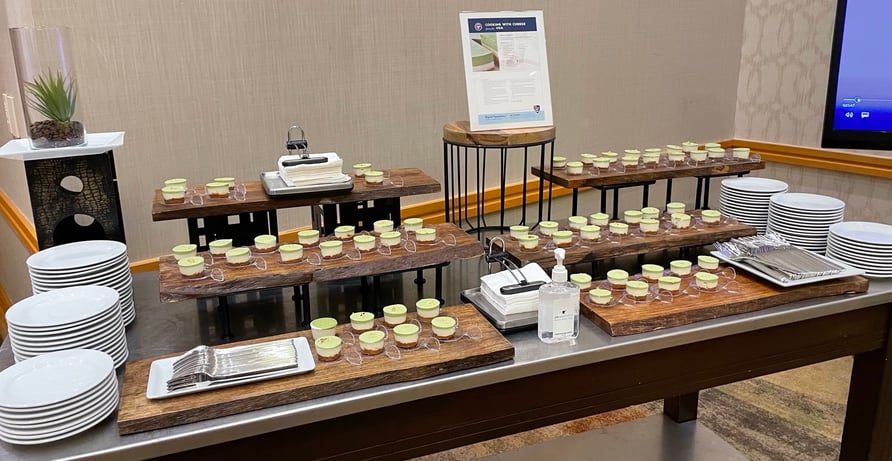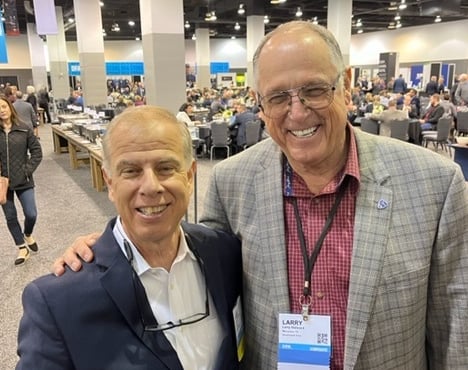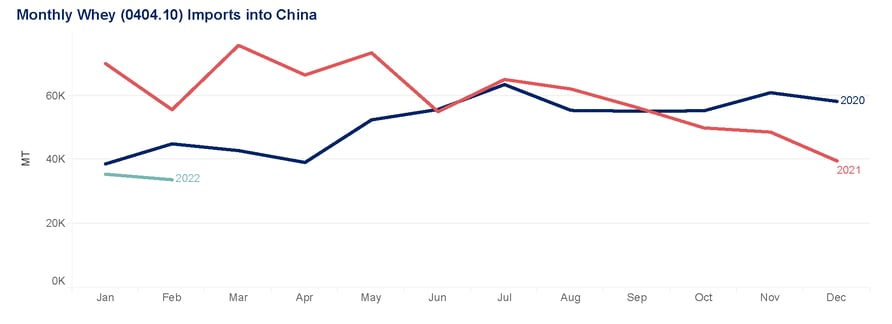HIGHLIGHTS: MARCH 25, 2022
• Farmers get immersion course in exports
• January-February China dairy imports
• Shipping bill set for conference
• Report highlights agriculture’s economic impact
• New prototypes to debut at Japan dairy protein webinar
• Sign up now: Latin American trade shows return
• Last chance to register for USDEC spring meeting
• Market Summary: NZ milk down again
• USDEC Data Hub: Chinese whey imports
• Hoeger calls for FTAs
• White House seeks new chief ag negotiator for USTR
• Key export markets continue to lift COVID restrictions
• Denmark criticize d for using “feta” name
• Harden takes to the airwaves
• Company news: Lactalis, FrieslandCampina, TINE, Fonterra
Featured
Farmers get immersion course in dairy exports at DMI Dairy Forum
Dairy farmers in general recognize how U.S. dairy exports have grown over the years. But a surprising number are unfamiliar with the breadth and depth of the international market work of USDEC and Dairy Management Inc. (DMI), how it has contributed to U.S. dairy export expansion and what the organizations are doing specifically to foster further international development.
Last week’s DMI Dairy Forum provided an opportunity to fill in and update any dairy export knowledge gaps. The event brought together 260 dairy farmers, young and upcoming leaders, to hear how their checkoff investments are helping lay the groundwork for U.S. dairy industry growth.
Not only were opening comments evenly split between export and domestic programs, but USDEC staff worked with representatives of DMI’s Global Innovation Partnership (GIP) to put attendees through a mini-immersion program in exports. Vikki Nicholson-West provided the export half of the opening session, outlining key export market trends, opportunities and challenges.
Then Nicholson-West, Angélique Hollister, Terri Rexroat and Ryan Hopkin from USDEC joined Amy Wagner and Rebecca MacKay from DMI in a program themed “Around the World with U.S. Dairy.”
Gateways to dairy exports
They designed a series of stations—or “gates” as in airport gates, in keeping with the travel theme—that took attendees through examples of the work USDEC and the GIP team are doing on their behalf. Three gates focused on different aspects of checkoff-funded international activities: partnerships, “The World of U.S. Dairy Exports” and promotions.

Each export “gate” featured an infographic backdrop highlighting specific USDEC and DMI export efforts—in this case promotions—and U.S. dairy export growth.
The 260 dairy farmers split into 12 groups, and leaders from participating state and regional dairy associations led each group through the “around the world” tour, rotating from gate to gate for 10-minute presentations at each. Each gate offered snapshots of U.S. dairy exports—such as key markets, products sold, how U.S. cheese and ingredients are being used, and key partnerships—and what USDEC and DMI’s GIP team do to help drive demand.
The tour concluded at a fourth station featuring a variety of retail products containing dairy ingredients from a range of export markets. Other tables offered products for sampling that were developed in collaboration with USDEC and made with U.S. dairy products: a matcha cheesecake made with U.S. cream cheese, high protein mango pudding made with U.S. WPC 80 and milk powder, and pizza made with U.S. mozzarella cheese sold at Domino’s in Japan.

Farmers sampled mini matcha cheesecakes developed through USDEC’s culinary work in Japan.
Farmers were also given a “passport”: a booklet recapping the information shared during the experiential export session that they can reference at their leisure after the meeting and share with the broader farmer community.
Positive feedback
At the end of the day, which included additional presentations on domestic U.S. checkoff activities, each of the 12 groups of farmers was given an assignment for the next morning: write down the top three headlines of learnings from the previous day. Their answers indicated a renewed, deeper understanding of the value of exports and how checkoff-funded activities are helping to deliver growth.
“Every breakout group report spoke on the importance of exports to our businesses and the need for the U.S. to be the dairy supplier of choice,” said Texas dairy farmer and USDEC Chairman Larry Hancock. “The forum was an informative, enlightening, encouraging meeting. As a farmer, I want to thank USDEC for the work and efforts supporting my farm. USDEC’s efforts are recognized and appreciated by farmers and members.”
China dairy imports mixed over first two months
Chinese WMP demand started 2022 with a bang, but most other product categories posted mixed results over the first two months of the year, sending overall Chinese dairy import volume down 3% for January-February.
China kicked off the year with record WMP purchasing, clearing 300,000 MT in the first two months—a gain of 24% over the previous year. At 229,154 MT, January marked China’s biggest single-month of WMP imports ever.
On the opposite side, the nation’s pig industry—struggling financially due to low prices—continues to depress whey demand. Year-over-year whey imports fell in each of the first two months and were down 44% through February. That marks five straight year-over-year declines dating back to October.
All other products fell somewhere in between soaring WMP demand and plunging whey purchases. The pattern for all other major product categories was similar: decline in January, rebound in February.
Chinese cheese imports fell 38% in January and rose 11% in February. SMP fell 21% in January and rose 5% in February. Butterfat dropped 18% in January and jumped 61% in February. Lactose dipped 8% in January and increased 32% in February. Fluid milk and cream were down 3% in January and grew 1% in February.
While overall numbers for the first two months of the year were running slightly behind previous year totals, the strong volume for WMP and the across-the-board rebound in all other major dairy categories except whey in February point to continued solid dairy demand out of China to start the year. However, surging cases of COVID-19 this month, widespread lockdowns and supply chain disruptions are creating some short-term demand uncertainty for the upcoming months.
OSRA bill set for conference; USDEC highlights supply chain efforts
The Senate Commerce Committee passed the Senate version of the Ocean Shipping Reform Act (OSRA) on Tuesday, bringing the legislation one step closer to reality. The approval sets the stage for the conference process to resolve the differences between the House and Senate versions.
The OSRA is part of the Senate-passed U.S. Innovation and Competition Act (USICA) and the House-passed America Creating Opportunities for Manufacturing, Pre-Eminence in Technology and Economic Strength (COMPETES) Act.
“Dairy exporters need the changes OSRA would deliver. As such, we encourage Congress to swiftly move the COMPETES/USICA conference work forward and send a bill that prioritizes the export shipping needs of U.S. agricultural exporters to the president’s desk,” said USDEC President and CEO Krysta Harden in a joint USDEC/NMPF press release on the legislation.
Rice lays out supply chain efforts
USDEC estimates the ongoing supply chain crisis cost U.S. dairy suppliers more than $1.5 billion in 2021 due to reduced value, higher direct costs and lost sales. That does not count the damage to the U.S. reputation as a reliable supplier.
The gravity of the problem is clear, as USDEC Trade Policy Manager Tony Rice makes plain in the Hoard’s Dairyman column, “Dairy must overcome export obstacles.” Rice quickly recaps what’s at stake and explains how USDEC has been working to resolve the crisis, the progress made to date and the need for more policy improvements moving forward.
Report underscores agriculture’s economic impact
National Ag Day, March 22, served as the backdrop for the release of the sixth annual “Feeding the Economy” report. The report, an analysis of how the U.S. food and agriculture sectors affect the overall U.S. economy, showed that despite the pandemic, the industries remained resilient last year to provide Americans with jobs, economic opportunity and safe food.
The study determined that 7% of the U.S. economy and 29% of American jobs are linked directly or indirectly to the food and agriculture sectors. In dollar terms, ag exports totaled $183 billion in 2022, and the overall impact on the U.S. economy was $7.43 trillion. The findings clearly demonstrate the powerful effect of food and agriculture on the nation’s economic health.
The analysis breaks down the impact by state and congressional district. To look up your location or findings from other states or congressional districts, go to the Feeding the Economy home page and scroll down to the interactive U.S. map. Thirty U.S. food and agriculture organizations sponsored the report, including USDEC and NMPF.
Events
Prototypes from Kiyota Sangyo partnership to star at upcoming Japan dairy protein webinar
Central to USDEC’s efforts to build global demand for U.S. dairy ingredients is the concept of local-friendly product innovation in market. USDEC, often in collaboration with in-country partners, works to develop on-trend new-product prototypes tailored to regional cuisines featuring U.S. dairy ingredients—and then highlight those to local food and beverage manufacturers.
The upcoming April 20, 2022, webinar, “Protein Products at the Forefront! Trends From Overseas and New Potential for Japan-Friendly Applications,” will highlight five new prototypes developed by USDEC partner Kiyota Sangyo. The five products—warabi mochi mix, instant miso soup packets, chicken sausage, chocolate spread (for manufacturing use) and salmon paste—feature U.S. WPC and/or MPC. The products deliberately go beyond more traditional uses for U.S. dairy proteins, like beverages and protein bars, to empower attendees (food and beverage product developers) with new ideas for Japanese-friendly innovation.
Pikosky, Berry to speak
Presentations by long-time USDEC collaborators Donna Berry, owner, Dairy & Food Communications, and Matthew Pikosky, vice president, nutrition research, National Dairy Council, will bookend the prototype session from Kiyota Sangyo scientists.
Berry will kick off the event by exploring dairy protein trends and innovative health and wellness products from a U.S./Western perspective, highlighting snack foods, refrigerated desserts, ice cream, spreads, pizza and other product categories ripe for protein innovation in Japan. Pikosky will go beyond dairy protein’s role for healthy aging in his presentation, delving into other science-backed health and nutritional benefits, particularly metabolic health.
Details
The webinar will take place April 20, 2022, starting at 2:00 p.m. Japan time (April 20, 1:00 a.m. ET). USDEC members are welcome to listen in, but it will be held in Japanese only. Click here for more information on the event. A registration link will be posted before the end of the month. For questions or more information, please contact Allison Guzman at aguzman@usdec.org. For a full list of upcoming USDEC marketing activities, visit the online Marketing Events calendar at usdec.org.
Exhibit with USDEC at Latin American trade shows
After two years of pandemic restrictions, in-person trade shows are back on the calendar in Latin America. USDEC invites U.S. dairy ingredient suppliers interested in reengaging and building business in the region to sign up for space within the USDEC booth at one of the three 2022 events listed below (which include sign-up deadlines). Space is limited and will be assigned on a first-come, first-served basis.
For questions or to enquire about a spot in the USDEC booth, please contact Allison Guzman at aguzman@usdec.org. For a full list of upcoming USDEC marketing activities, visit the online Marketing Events calendar as usdec.org.
Still time to register for next week’s USDEC’s spring meeting
You can still register for USDEC’s Spring Annual Membership Meeting that takes place March 28-29 at the Westin Denver Downtown in Denver, Colorado. The meeting is hybrid, so even if you can’t make it to Denver in-person, you can participate online from the comfort of your office.
Because we know we can’t reach all of your coworkers, why not invite a colleague to attend the meeting?
You can download the final program for the meeting here. If you have any questions about the agenda, registration or anything else, please contact Weston Abels at wabels@usdec.org. We hope to see you in Denver!

USDEC Executive Vice President for Policy Development and Strategy Jaime Castaneda and USDEC Chair Larry Hancock pause for a photo at last week’s Dairy Farmers of America annual meeting.
Market Summary
NZ milk falls again; global poverty concerns rise
New Zealand milk production plunged 8.2% in February, marking the seventh straight month of year-over-year decline. At 1.77 million MT, it was the worst output in February since 2013. The results put 2021/22 milk production down 3.3% to date.
Global milk supply remains very tight and concerns are rising about escalating dairy pricing as well as overall global food prices. Washington-based think-tank the Center for Global Development estimates Russia’s war on Ukraine will push more than 40 million people worldwide into extreme poverty (defined by the World Bank as people living on less than US$1.90 per day). The main cause: rising food commodity prices.
Here are a few of the concerns:
- Ukrainian farms are about to miss critical planting and harvesting seasons. Russia and Ukraine are major wheat suppliers to Asia and Africa, raising fears of potential shortages.
- Russia, Ukraine and Belarus are major fertilizer suppliers to the world, driving already high fertilizer prices even higher. As a result, farmers from Brazil to Texas are cutting back on fertilizer, threatening yields for the next harvest.
- China is facing its worst wheat crop in decades due to poor weather. It is also turning to the U.S. to supplement corn stocks that it would usually purchase from Ukraine.
From a dairy standpoint, coupled with increased energy costs (which are also being fueled by the conflict), it translates to rising input costs and less incentive to boost production. From a broader global standpoint, it spells higher food prices worldwide.
USDEC Data Hub: Chinese whey imports
Each week, Global Dairy eBrief features a different chart from the USDEC Data Hub. The hub collects dairy production, pricing, export and import numbers and organizes them into a series of meaningful, interactive tables and graphs for members to investigate trends, plan export strategies and seize global opportunities.
This week’s issue highlights Chinese whey imports. You can find the graph at the Data Hub under the U.S. Exports tab.
We encourage you to visit the Data Hub and experiment with an interactive version of this and other charts, graphs and tables. If you have any questions regarding the information, please contact William Loux at wloux@usdec.org.

Chinese whey imports in February fell to 36,116 MT, their lowest level since June 2019.
Trade Policy
Hoeger calls for U.S. trade deals during Farmers for Free Trade town hall
Chris Hoeger, vice president of procurement for USDEC member Prairie Farms Dairy called on the U.S to pursue comprehensive trade agreements during the March 23 Farmers for Free Trade virtual town hall.
“We appreciate the administration’s important work in enforcing existing trade deals, including the U.S.-Mexico-Canada Agreement, but without new access opportunities, U.S. dairy exports will continue to face a disadvantage, and American jobs will suffer as a result,” said Hoeger, who is also a participant in USDEC’s Dairy Trade Envoy program.
American dairy exporters will face an increasingly unbalanced playing field in the future if the U.S. remains on the sidelines while our major competitors—the EU and New Zealand—forge ahead with their own new agreements, Hoeger said.
Click here to read the joint USDEC/NMPF press release on Hoeger’s participation in the town hall. For more on Farmers for Free Trade, click here.
Trevino withdraws name from USTR ag negotiator consideration
Elaine Trevino, President Biden’s nominee as chief agriculture negotiator at the U.S. Trade Representative (USTR), withdrew her name from contention. Trevino had strong support from the U.S. food and ag community including from USDEC. However, six months after her nomination, she hadn’t received a hearing from the Senate Finance Committee. Lawmakers were told there were “paperwork issues” with the nomination. The White House reportedly seeks to appoint Trevino to a non-Senate confirmed post, possibly a senior role at USDA.
The USTR chief ag negotiator position is central to improving and expanding market access for U.S. dairy and food sectors in trade agreements. USDEC has been calling for swift appointment for that position as well as USDA Under Secretary for Trade and Foreign Agricultural Affairs since the start of the Biden Administration. (Politico, 3/15/22)
Market Developments
Singapore, Indonesia, Japan ease COVID restrictions
Key U.S. dairy export markets continue to lift business and travel restrictions. This week, saying its “fight against COVID-19 has reached a major turning point,” Singapore announced it was lifting quarantine requirements for all vaccinated visitors starting in April. Singapore is also removing a 10:30 p.m. curfew on dining and alcohol sales, and will allow more employees to return to their workplace.
Effective immediately, Indonesia lifted all quarantine rules for fully-vaccinated visitors after a successful two-week trial program on major resort destinations. Japan removed “pre-emergency” designations on 18 prefectures that had limited hours of operations for restaurants and other businesses. (USDEC Japan office; Reuters, 3/24/22, 3/21/22; Bloomberg, 3/21/22)
EU court advisor says Denmark violating law in using ‘feta’ name
An advisor to the Court of Justice of the European Union announced that Denmark was breaching EU law in allowing companies to manufacture and export cheese using the name “feta.” The court advisor, Advocate General Tamara Capeta, said that by neglecting to stop Danish cheesemakers from using “feta” for cheeses exported to countries outside the EU, “Denmark failed to fulfill its obligations under EU law.” She dismissed Denmark’s argument that an export ban could be seen as an obstacle to trade.
Greece has been complaining for years about cheesemakers from other countries using the generic name “feta.” Claiming that Denmark was ignoring feta’s “Protected Designation of Origin” status in the EU, Greece formally requested that the European Commission (EC) probe Denmark’s actions related to feta. The EC began investigating in 2018, ultimately referring the case to the Court of Justice in 2019.
While the court has yet to rule in the case, it follows such nonbinding recommendations from advisors about 80% of the time. (Greek Reporter, 3/18/22; Reuters, 3/17/22)
USDEC in the News
Harden talks USDEC’s purpose, dairy exports and 4-H
USDEC President and CEO Krysta Harden hit the airwaves over the past couple of weeks conducting interviews on the Your Dairy Checkoff podcast, Dairy Business’s DairyVoice podcast and USDEC’s own U.S. Dairy Exporter Blog. Harden addressed an array of topics.
- For the farmer audience listening to Your Dairy Checkoff, she offered some of the basics on USDEC’s mission and funding, what exports mean to U.S. milk markets and milk checks, the value of U.S. dairy sustainability efforts, how USDEC highlights and differentiates U.S. dairy from competitors, the U.S. Center for Dairy Excellence and other topics.
- For DairyVoice, she discussed the past year’s challenges and achievements and where she sees U.S. dairy exports headed in the year ahead.
- For the U.S. Dairy Export Blog interview (released to coincide with the celebration of National Ag Day on March 22), Harden explores how 4-H prepared her for executive leadership in government, business and the U.S. dairy industry.
Company News
FrieslandCampina to close powder towers, fresh dairy plant
Dutch dairy giant FrieslandCampina is closing two milk powder drying towers at its Leeuwarden, Netherlands, facility, as well as its fresh dairy product plant in Maasdam. The closures are part of the company’s plan to refocus its portfolio on value-added products. Leeuwarden will shut down May 1, 2022. Friesland Campina did not specify a date for Maasdam’s closure but said it would take place no later than December 2023. (Company reports)
TINE plant expansion targets export markets
Norwegian dairy processor TINE opened a $26-million cheese expansion at its Storsteinnes, Balsfjord, plant. The project is part of TINE’s plan to grow its dairy export business. The facility can produce 2,600 MT of traditional Norwegian brown cheese and 2,600 MT of goat and other cheese types. TINE initially plans to target South Korea, where brown cheese has been gaining a following, with other Asian markets to follow. (DairyReporter.com, 3/21/22)
Fonterra to exit Russia
New Zealand’s Fonterra Co-operative Group is exiting its Russian ventures. The co-op is closing its Moscow office and withdrawing from its joint venture with Russia’s Unifood that started in 2018. Fonterra said it is confident, given current market conditions, that it can find a home for product it was shipping to Russia. In 2021, that included 13,352 MT of butterfat, 1,811 MT of SMP and 1,445 MT of WMP.
Separately, Fonterra said it was continuing to make progress on divesting its Chilean dairy business and on reviewing its Australian business. (Company reports)
Company news briefs
Lactalis Chairman Emmanuel Besnier is taking over CEO responsibilities (although Lactalis has not said he will hold that title), and long-serving executive Thierry Clément has been appointed to the newly-created role of chief operating officer. Former CEO Philippe Palazzi stepped down in February. … Saudi Dairy and Foodstuff Co. (SADAFCO) added 215,000-sq.ft. of space to its Jeddah production facility, nearly doubling the size of the plant. The addition will focus on ice cream production. … Cargill opened a new technical application center in Turkey that will serve as a regional innovation hub to support dairy customers in the Middle East, Turkey and Africa. The facility includes a pilot plant and blending capacity. (USDEC Middle East/North Africa office; just-food.com, 3/24/22; FoodBev.com, 3/16/22)
In Case You Missed It...
U.S. Dairy Exporter Blog
Market analysis, research and news subscribe hereUSDEC Twitter feed
Follow us here.